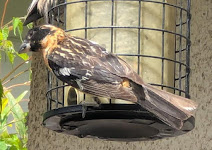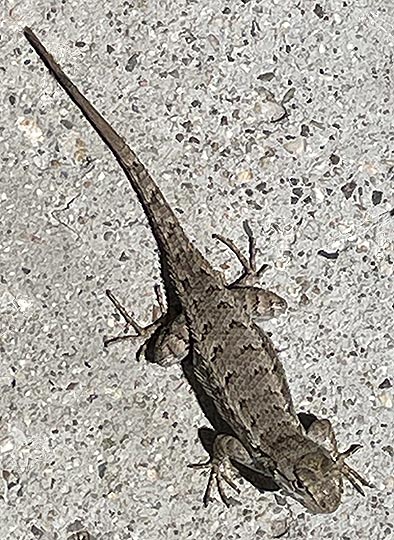Earlier this year, I posted a blog on aquatic birds sighted north of Los Angeles (Castaic Lake and Santa Clarita areas, which are only six miles apart from one another]. Since then, some new sightings and images concerning both aquatic and a few non-aquatic birds in both areas have become available to me, mostly via my well-informed source, who lives in the Castaic area.
AQUATIC BIRDS (CASTAIC LAKE AREA)
CANADA GOOSE
Branta canadensis
Most of the Canadian Geese that were present in this area in January, 2025, have now migrated away [this is definitely true for the Snow Geese and most of the coots]. However, a few Canadian Geese remain, and now include some immature Canadian Geese. An image of one family that remained in the Castaic Lake area is shown below. I have also spotted some other immature Canadian Geese in the Santa Clarita area, a few miles south of Castaic Lake.
Young Canadian Geese and their "mom" at Castaic Lake.
_________________________________________________________
WESTERN GREB (The Swan-Necked Grebe) Aechmophorus occidentalis
About 3 pounds in size.
This aquatic bird has a distinctive curved neck, with crisp black and white colorations sharply defined. They rarely walk (= an awkward gait) on land, but they can gracefully “run” on water. They have lobed toes to propel them underwater (note: ducks have webbed feet). Their eyes are red. These birds are almost always in the water, where dive (for long periods of time) for prey or rest on the surface. They build floating nests (Wikipedia, 2025).
Western Greb at Castaic Lake.
_________________________________________________
COMMON MERGANSER
Mergus merganser
About 3 pounds in size.
This aquatic bird is duck-like that lives in rivers and lakes. The male has black head, red bill, and mostly white body (possibly with some grayish patches); the female has red head, red bill, white chin, and white to gray body (Wikipedia, 2025). Its common name is “sea duck.”
NON-AQUATIC BIRDS (CASTAIC LAKE AREA)
RED-WINGED BLACKBIRD
Agelaius phoenixes
8.5 inches length
This species lives all over the USA except near the Canadian border.
The red epaulets are displayed in courtship from Fall until nesting begins.These birds live in large flocks. They spend the nights in communal roosts and fly out together in search of food. Their main habitats are marshes and pastures. They also frequent parks in rural areas. The male is black with yellow-edged epaulets, which may be hidden when the bird is perched. The female is streaked brown with a faint red tinge on the shoulders and a pink throat. The epaulets of the California form lack the yellow edges. These birds are among the first to fly north. They will attack hawks and crows. The nesting season of these birds is March through July. (Audubon bird book, 1999, p. 130). I recently spotted two of these birds in a front yard in Santa Clarita, California), six miles from Castaic Lake.
__________________________________________________
male female
BLACK-HEADED GROSBEAK
Pheuciticus melanocephalus
7-8.5 inches long
Their nest is a loose and flimsy structure of plant rootlets and twigs built in thick foliage (including trees or shrubs that are 4 to 25 feet above the ground. This bird eats seeds and insects. (Audubon bird book, 1999, p. 119 (in part); and Reader's Digest "North American Wildlife" (p.149).
_________________________________________________
WESTERN TANAGER
Piranga ludoviciana
7 inches long
Orange head, yellow chest, black back and wings. Male has brighter colors than female. Male’s head is red during the breeding season but disappears in the fall. Eats insects, berries, and other fruit. Its nest consists of twigs, roots, and moss. Lives in western USA and south-west Canada. Can live at elevations up to 10,000 feet.
(Audubon bird book, 1999, p. 117).
__________________________________________________
COOPERS HAWK
Astur cooperii
Medium-sized hawk.
This hawk has a black cap, dark gray upper wings with scattered black spot, and white legs with back spots. Upper surface of wings brown; the underneath surface grayish white with black streaks and spots. This hawk is native to North America and found from southern Canada to Mexico (Wikipedia, 2025). They nest in tall trees with extensive canopy cover.
A medium-sized hawk (they weigh about a pound and the male is smaller than the female). This hawk is known for its stealthy hunting and preference for small to medium-sized bird prey. Crows do not like them! These hawks are often seen in suburban areas and around bird feeders. They can also feed on snakes, squirrels, and even chickens. These hawks have a varied collection of bird calls that is one of the largest for any raptor (Wikipedia, 2025).
NON-AQUATIC BIRDS (Santa Clarita)
MOURNING DOVE
Zenaida mercury
12 inches long.
This is the smallest in size of the three dove species that live in the Los Angeles, California area. This species is primarily a seed eater and not an insect eater. It especially likes sunflower seeds. is a migratory game bird. As I researched it, I was astonished to learn that this peaceful animal (which is a symbol of peace, love, and hope) is the most frequently hunted game bird in North America.
It has a small head and a slender tail. It flies “bullet fast” and usually can live 2 to 4 years although some in captivity can live up to 30 years. It is most active in the early morning and late afternoon. They are related to pigeons, which are a type of dove. Unlike pigeons, mourning doves are illegal to own.
Front and back views of same specimen (about 8 inches in length) of mourning dove in my garden in Santa Clarita, northern Los Angeles County, Southern California.
REFERENCES
Audubon backyard birdwatcher, birdfeeders and bird gardens. 1999. Thunder Bay Press, San Diego, CA, 381 pp.
Horsfall, R. B. and C. E. 1928. Birds of the Pacific Coast. Nature Magazine, Washington. Archive.org [the text is about 700 pp. long and has detailed sketches [some in color] of nearly every known bird species from this region]. This relatively unknown reference is easily available (you can view it for free at archive.org). For a small donation (the amount is up to you), this book can be downloaded. R.B. Horsfall was a renowned American wildlife illustrator of wildlife and also some fossils (see one my forthcoming post about earliest rhinos of California).
Reader's Digest North American Wildlife 1982. Pleasantville, New York, 1982, 559 pp. of text.
Wikipedia. 2025.















